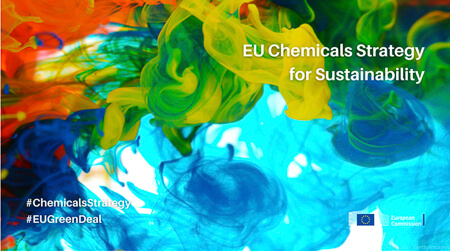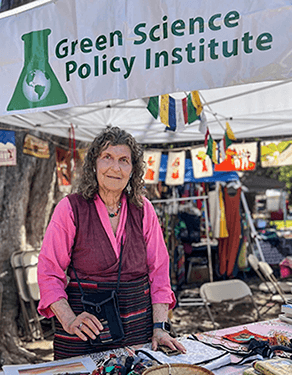May 2025: Brainstorm to Breakthrough
In this edition:
- Multiple Generations in Michigan Still Harmed by Chemical Contamination from 52 years Ago
- Old Paper Mill Pollution Still Haunts This Community
- From Beagles to the Bay: Reducing Pet Pesticide Pollution
- Can Europe Regulate Polymers for a more Circular Economy and a Healthier World?
- Green Science Policy Institute in the News
- Calendar
I’m happy to share with you that our recent three-day-long Six Classes Toxic Reduction Retreat was enjoyable and productive. Two dozen enthusiastic colleagues from the business, academic, government, and nonprofit sectors with a shared passion for reducing the use of harmful chemicals joined us for creative brainstorming and problem-solving sessions and came up with innovative new ideas. We also enjoyed bird watching, hiking, and dance parties!

On antimicrobials, our retreat participants helped us create a roadmap for advancing the California Safer Soap Act. This bill will protect people from washing their hands and bodies with unnecessary and harmful antibacterial chemicals that can contribute to antimicrobial resistance. Both the FDA and CDC say that “antibacterial” soaps are no more effective in preventing disease than plain soap. Several participants with extensive expertise in California policymaking are helping us build a multi-stakeholder coalition to get this common-sense legislation across the finish line next year.
Another session discussed an important and complex topic: the lifecycle harms of big molecules called polymers and their need for regulation. We particularly focused on flame retardants and PFAS polymers. A groundbreaking paper we recently coauthored in Nature Sustainability demonstrated that flame retardant polymers can break down into smaller harmful chemicals. During our retreat, participants came up with action steps to encourage more research and attention to this topic, such as connecting it to broader efforts to curb plastic pollution. You can read more about the polymer issue below.
We also tackled the intersection of climate and chemicals. Our participants, including both climate and toxics experts, confronted head-on the reality that reducing carbon use for fuel can inadvertently increase its use in plastic and toxics and moving to safer chemicals could use more energy. Having both climate and chemical scientists working together in the same room seems a good beginning to progress on this tricky problem.
As you might recall, last month on Earth Day 2025 we launched our Institute’s visionary new Senior Fellows Program to support leading environmental health scientists and policy experts in developing and implementing new ideas to reduce chemical harm. Two of our Senior Fellows, Meredith Williams and Joel Tickner, are working on strategies towards solving the problems of climate and chemicals together. Gretta Goldenman and Marty Mulvihill were also in attendance, and we revisited our joint New York Times opinion piece on the intersection of climate, plastic, and toxics.
Meanwhile, our joint study finding harmful and unnecessary flame retardants and phthalates in children’s mattresses continues to generate media coverage and effect change. The UK’s mattress trade association reacted to the study by issuing guidance for its members, and a leading US foam certification body has reached out to understand how manufacturers can test for and eliminate these chemicals in their supply chains. We are delighted that our study is already prompting a transition to children’s mattresses without these problematic chemicals.
Finally, I hope you’ll join me this weekend for the fun and festivities at the annual Berkeley Himalayan Fair on May 17 and 18. I founded this joyous community celebration 42 years ago after enjoying the festivals of the Himalaya during my ten-month trek across Bhutan, Sikkim, Nepal, and India. This is one of my favorite community events of the year. You can learn more below and stop by my booth under the big tree across from the stage to say hello.
Kind regards,
Arlene and the Green Science Policy team
P.S. If you are a doctoral student or postdoctoral fellow in a field related to environmental health, green chemistry, or chemicals policy and would like an occasional mentoring conversation with one of our Senior Fellows, please send your resume and research/career interests to Anna.
Multiple Generations in Michigan Still Harmed by Chemical Contamination from 52 years Ago
By Arlene Blum
Over fifty years ago in Michigan, Velsicol Chemical made a big mistake which is harming the health of people in Michigan to this day. By accident, a toxic flame retardant called polybrominated biphenyl (PBB), was substituted for a feed supplement being distributed by the Michigan Farm Bureau. The chemical was added to livestock feed across the state, exposing millions of Michigan residents who ate contaminated beef, chicken, pork, milk and eggs for over a year until the cause for dying herds of dairy cows was discovered by a dairy farmer with a degree in chemistry. Millions of farm animals who ate the contaminated feed had to be killed.
The disaster was made into an award-winning movie called "Bitter Harvest" (1981), and detailed in Joyce Egginton's classic book The Poisoning of Michigan. I was honored to be asked to co-author the afterward for a new edition of this account of this toxic tragedy told with the suspense of a detective novel.
A State of the Science Review of Human Health Effects of the Michigan Polybrominated Biphenyl Contamination after Five Decades details the studies on long-term and multigenerational health effects that continue to impact those who were exposed to PBBs half a century ago, as well as their children and grandchildren.
Health harms include higher rates of breast cancer and miscarriages in women and an increase in adverse genitourinary conditions and epigenetic alterations of spermatogenic cells in sons of the exposed. A registry for ongoing studies and more information can be found here.
These findings are especially concerning as PBBs are very similar in structure and properties to the PBDEs that were used as a flame retardant in furniture and baby product foam for decades and can still be found in older products in our homes, leading to continuing exposures today.
The publication of the manuscript for this important review paper without the benefit of proper formatting illustrates a different sort of toxic tragedy occurring right now. This important research was among the final papers published by Environmental Health Perspectives in late April 2025 just as this high-impact journal ceased publication due to a loss of their NIH funding. You can learn more about this huge loss to environmental health research in the New York Times.
To end on a more positive note, the work of our Institute and our NGO colleagues to change standards so flame retardants are no longer needed in our furniture and baby products across the U.S. and Canada is decreasing our exposure to such harmful chemicals in our homes today.
Old Paper Mill Pollution Still Haunts This Community
By Rebecca Fuoco
Abandoned paper mills and factories cast a long shadow in America's heartland towns.
A new study led by Courtney Carignan at Michigan State University “Elevated per- and polyfluoroalkyl substances (PFASs) in tap water and serum in a community near an abandoned paper mill” reveals how PFAS contamination from these industrial ghosts can live on.
The study focused on Parchment, Michigan, where PFAS drinking water contamination from the old paper mill was discovered in 2018. The mill, which operated from 1909 to 2000, had disposed of waste containing PFAS in a landfill, causing elevated contamination in the surrounding groundwater. A “Do not drink” advisory was issued and the municipal water was then connected to the Kalamazoo water system which had tested below the federal drinking water advisory.
However, the researchers found that three years after the switch to clean water, participants had elevated levels of PFAS in their blood. Those who drank municipal water had significantly higher levels than those on private wells, and the risk increased with every additional year of exposure.
The authors warn that Parchment is not an isolated case. “This research highlights how vulnerable our drinking water systems can be to contamination from old paper mills or landfills,” says co-author Heather Stapleton. “This work underscores the importance of routine monitoring for contaminants in our drinking water.”
Courtney Carignan, the lead author, noted that, "While our paper is focused on drinking water contamination and exposure to legacy PFAS mixtures from a landfill that received waste from a former paper mill in Michigan, a recent study from NJ by Gloria Post documents production and discharge of a PFAS called PFNA from 1991-2010 that contaminated drinking water across the region. Other PFAS continued to be produced and discharged from the same facility until 2021, despite having similar toxicity."
Both studies highlight industrial sources of PFAS contamination, changes in PFAS mixtures over time, regrettable substitution, and the role of state and federal environmental agencies in health protection.
A final note: Gloria Post’s important paper went online as a manuscript without formatting as one of the final publications from the invaluable high impact journal Environmental Health Perspectives. We hope that this journal will be able to resume publication in the future as there are many more important papers such as this one that deserve to be told.
From Beagles to the Bay: Reducing Pet Pesticide Pollution
By Alexa Reynoso (Updated)
We all want our pets to be healthy and are concerned to learn that spot-on topical flea and tick treatments meant to keep them well could be a threat to the health of our ecosystems. Commonly used treatments such as Advantage, Frontline and PetArmor contain pesticides such as Fipronil or Imidacloprid that could harm the food web in the San Francisco Bay, according to scientists at the San Francisco Estuary Institute (SFEI).
These pesticides get on our hands and clothing, and when we wash our hands, our laundry, (or our pets), they head down the drain to wastewater treatment plants, and eventually end up in sediments at the bottom of the bay. According to Rebecca Sutton of SFEI, "that's the base of our food web. So, if those critters experience impacts, it could go up and harm our fish and our wildlife."
An SFEI study found Fipronil in all tested sewage treatment plants at concentrations above the U.S. EPA's recommended limit for aquatic ecosystems. Imidacloprid was also found at levels between 84 and 305 parts per trillion, well above the limit of 10 parts per trillion. A UK study also found a high environmental risk to UK aquatic ecosystems from Fipronil.
To protect both your pet and the environment, ask your vet if an oral chewable is an option. These effective tablets tackle internal parasites as well as fleas and ticks. They include monthly medications such as NexGard, Simparico, and Credelio and the quarterly tablet, Bravecto. If you prefer topicals over chewables, ask your vet about the monthly topical Revolution or the quarterly topical Bravecto. To reduce the risk of fleas in the first place, you can vacuum your home and your pet's bedding often (and empty the bag). See more tips for pet owners and veterinarians about chewable flea and tick medications from San Francisco Bay Area water agencies.
Can Europe Regulate Polymers for a more Circular Economy and a Healthier World?
By Anna Soehl
The general belief has long been that polymers—very large molecules—are too big to migrate out of products into people and therefore cannot cause health harm. As a result, polymers have largely avoided research and regulation.
However, the production and destruction of polymers during their life cycle can cause health harm to workers and nearby communities around the facilities that produce and dispose of them. Also, polymers, while in use, can contain leftover small molecule building blocks called monomers or can break back down into the smaller pieces. With the widespread uses of polymers in everyday products, this finding has major implications for our health and environment.

Our Institute supports the regulation of polymers and has encouraged and supported polymer research for the last decade. A 2019 study that we helped communicate showed that PolyFR, a polymeric flame retardant used in nearly all foam plastic building insulation, breaks down when exposed to heat and UV light. Similarly, a recent study that we first suggested documents that polyTBBPAs, used in electronics, can degrade into harmful smaller fragments that are found in soil near electronics recycling facilities and at diminishing levels moving away from the facilities.
A recent European Union brief on the health and environmental impacts of PFAS polymers describes the problems with polymers across their life cycle as did our Viewpoint on polyFR. The EU is revising its chemical regulations called REACH next year and are proposing taking the first steps towards the regulation of polymers.
By asking for data on polymers as part of its REACH revisions and a proposed universal PFAS restriction, Europe could help transition the global chemical industry towards a more sustainable pathway based on the “no data no market” principle. We will share comment period timing and other ways to support this much needed regulation of polymers as it moves forward.
Green Science Policy Institute in the News

Below are recent news articles, blogs, podcasts, newsletters, and more that have featured our Institute’s work and expertise.
- Our joint study on harmful chemicals in children’s mattresses received new media coverage, including in Science Alert, The Cool Down, Dallas Express, and more.
- An article in Homes & Gardens about reducing toxics in the home recommends our Six Classes website as a resource.
- A Health magazine article on reducing exposure to PFAS lists our PFAS-free webpage.
- In a feature about the continuing harms of PBBs in Michigan, Environmental Health News recommends our website as a resource for learning more about flame retardants.
- An article in Gadget Review recommends that people who want PFAS out of their outdoor gear to support our organization.
- A ScienceBlog article on research connecting plastics to heart deaths links to our webpage on phthalates and bisphenols.
- Our PFAS-free webpage was recommended in a news article from the University of Massachusetts Amherst.
- Flow Space included our website as a resource for learning how to reduce exposure to chemicals and microplastics.
Calendar
May 17 & 18, 2025:
Annual Berkeley Himalayan Fair
Live Oak Park, 1300 Shattuck Avenue at Berryman, North Berkeley.
Enjoy the food, music, dance, crafts and arts of the Himalayas at this fun free cultural event which began in 1983 as a way to increase friendship and understanding between Berkeley and the Himalayan regions.
Contact Arlene if you would like to volunteer to help at the Fair or at her booth under the big tree across from the entertainment stage. More information here.
Receive Updates By Email
Subscribe to our monthly newsletter and get these updates delivered right to your inbox!



